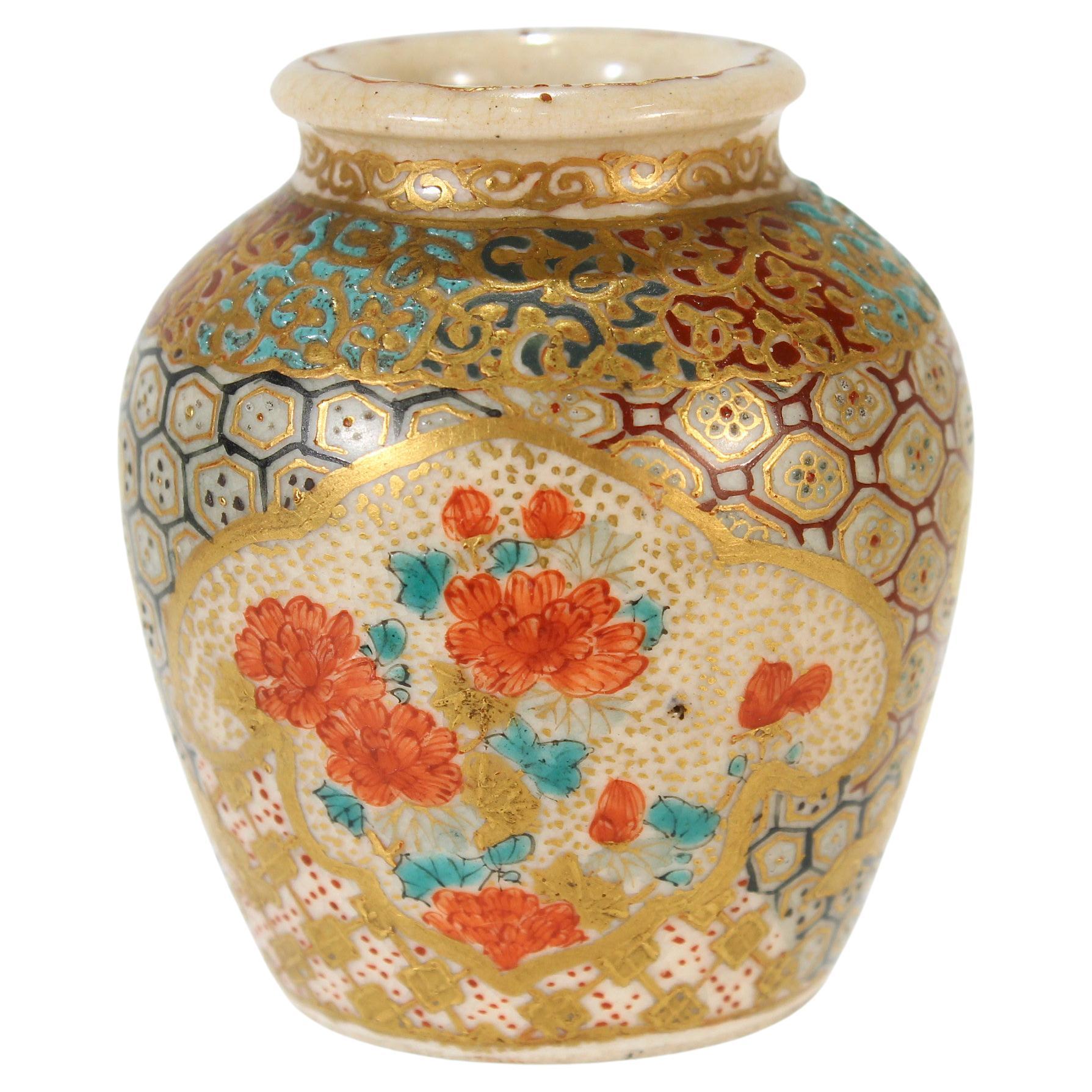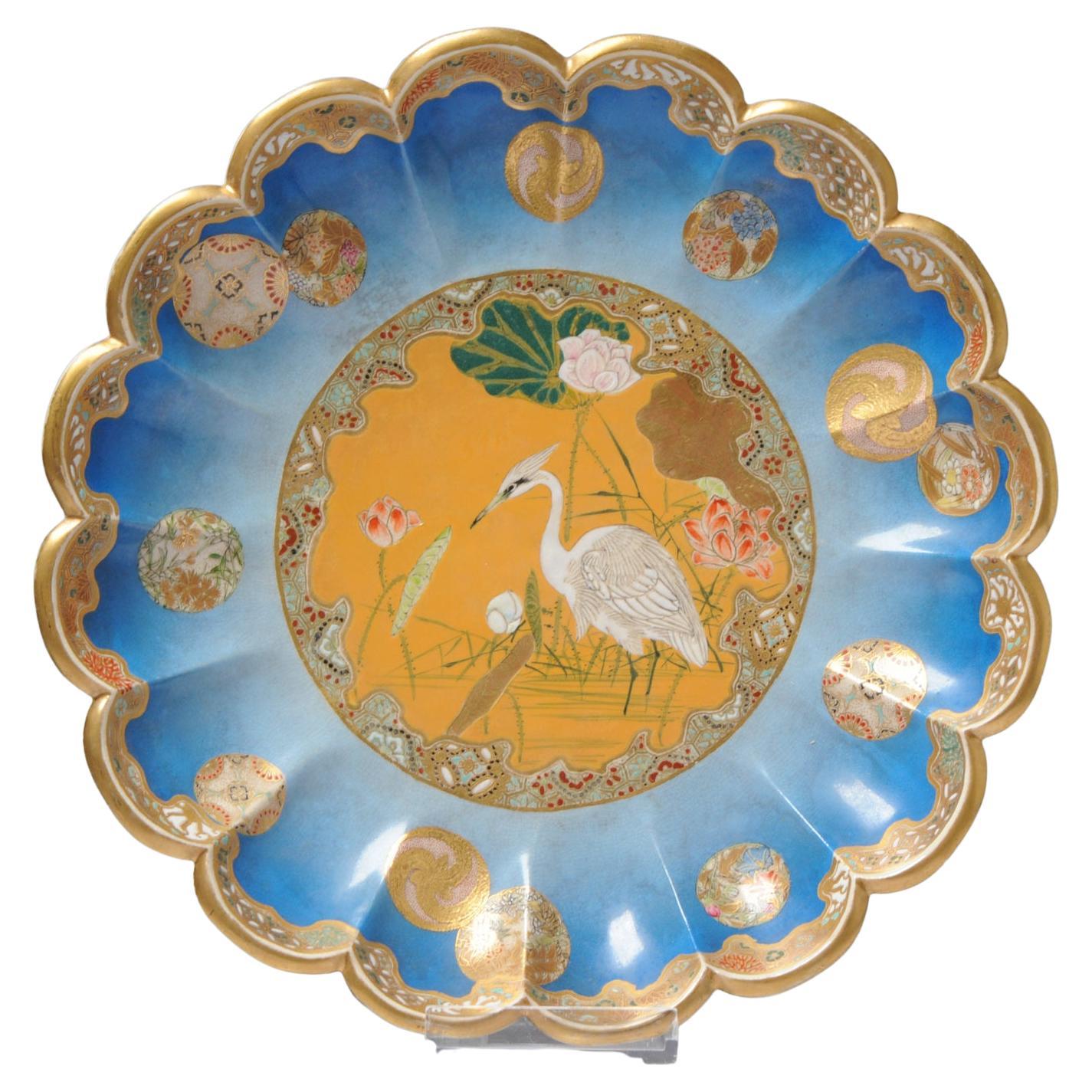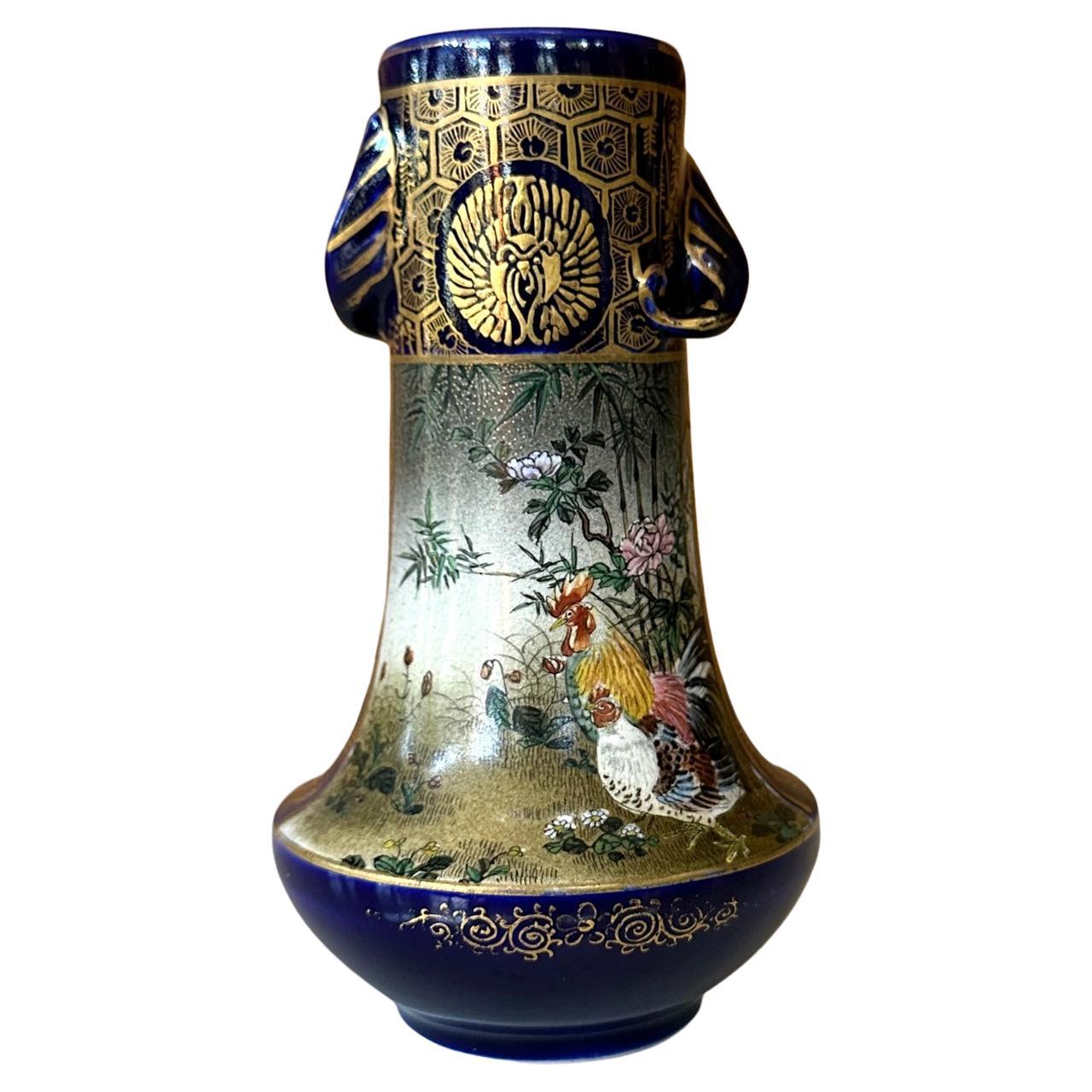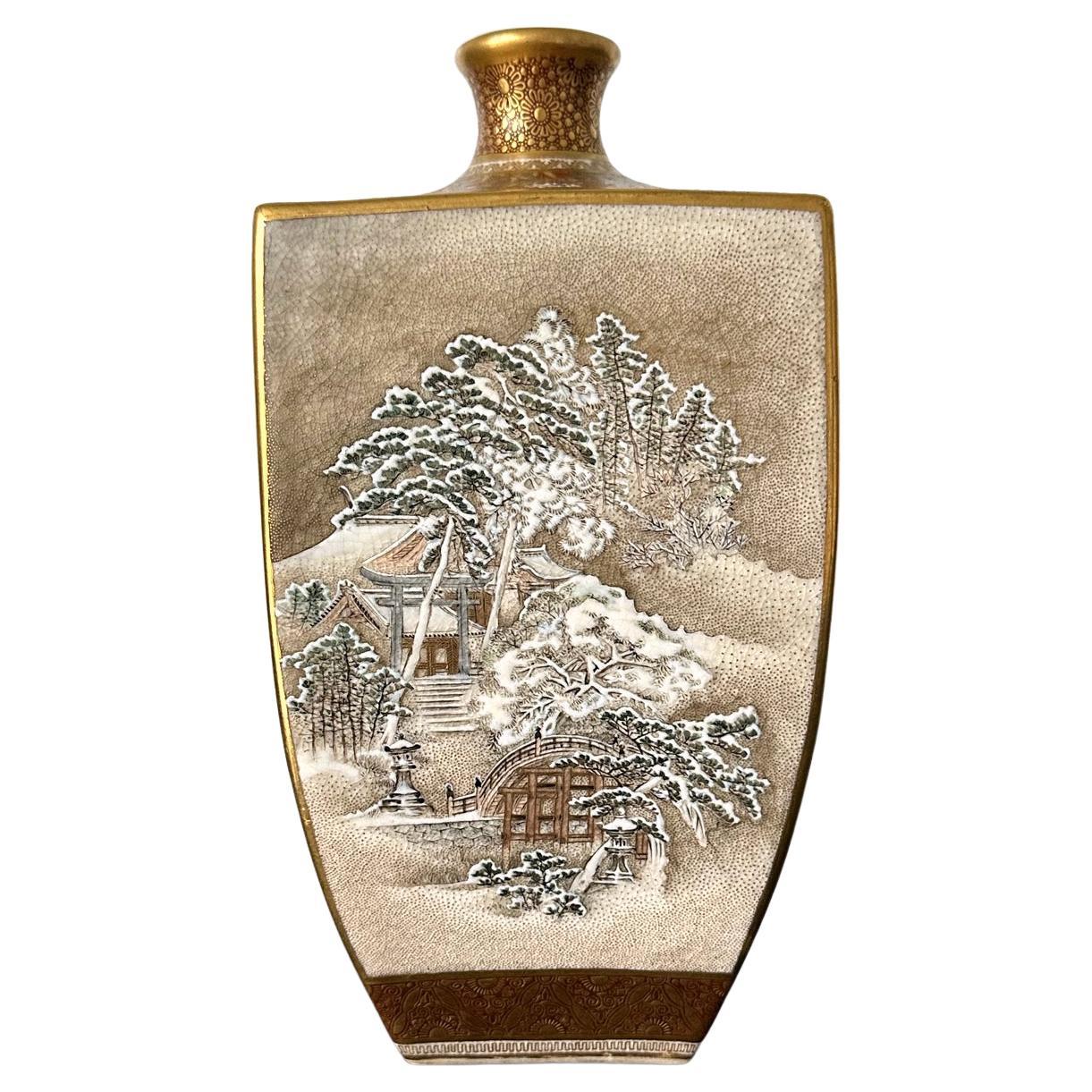Items Similar to Fine and Rare Miniature Satsuma Vase by Taizan Yohei
Want more images or videos?
Request additional images or videos from the seller
1 of 18
Fine and Rare Miniature Satsuma Vase by Taizan Yohei
About the Item
A very fine miniature ceramic vase in satsuma ware by Taizan Yohei (1864-1922) circa 1880-1890s of late Meiji period. The vase with a broad flat shoulder was lavishly decorated with colored enamels in merticulous details. On the background of mixed symbols, the exterior surface was showcased with three main scenes confined within the borders of "cartouches" of distinct shapes. One scene is a group of children gathered to play music instruments. The other is a group of ladies performing a formal court music. The third one is a pictorial depiction of nature in which an egret perched among lotus flowers. Between these larger cartouches, there are smaller imageries including an accoutrement of tea wares for chado and a lavishly wrapped gift box presented on a tray. On the shoulder, three small zones are centered with birds and butterflies evenly distributed among the symbolic background. The base is press-marked "Taizan". The workmanship of this vase is superb, and the subject matters are classical. The work can be compared with similar high caliber work by Yabu Meizan and Seikozan, who were celebrated for their miniature work of art.
Fine and miniature work like this vase is uncommon among the existing Taizan's work. This vase is likely dated to early period of his career. Taizan Yohei (Taizan IX) was adopted in 1878 into the Taizan family, a potter family active as early as 1670s. In 1872, Taizan VIII started to export of their products together with Kinkozan IV. Taizan IX continued to expand the family business and collaborate with Kinkozan until 1894 and possibly later until 1900s but at a smaller scale. His work with Kinkozan was mostly known in the west where they often co-signed the work.
- Dimensions:Height: 3.6 in (9.15 cm)Diameter: 3.25 in (8.26 cm)
- Style:Japonisme (Of the Period)
- Materials and Techniques:Ceramic,Enameled
- Place of Origin:
- Period:
- Date of Manufacture:1880s-1890s
- Condition:Wear consistent with age and use. Fine, a little gilt rubbing on the mouth rim and minimal shelf ware. Examined under UV without any issues.
- Seller Location:Atlanta, GA
- Reference Number:1stDibs: LU945031040682
About the Seller
5.0
Platinum Seller
These expertly vetted sellers are 1stDibs' most experienced sellers and are rated highest by our customers.
Established in 2006
1stDibs seller since 2010
478 sales on 1stDibs
Typical response time: <1 hour
- ShippingRetrieving quote...Ships From: Atlanta, GA
- Return PolicyThis item cannot be returned.
More From This SellerView All
- Fine Japanese Ceramic Satsuma Vase by KinkozanBy KinkozanLocated in Atlanta, GAA miniature Japanese ceramic vase from the end of Meiji period circa 1880s- 1910s by Kinkozan (1645-1927). One of the largest studio manufacturers of the export ceramics at the time ...Category
Early 20th Century Japanese Meiji Ceramics
MaterialsCeramic
- Japanese Miniature Satsuma Vase Yabu Meizan MeijiBy Yabu MeizanLocated in Atlanta, GAA small Satsuma vase from the studio of Yabu Meizan (birth name Yabu Masashichi; 1853-1934), who is one of the most celebrated and collectible Satsu...Category
Antique Early 1900s Japanese Meiji Ceramics
MaterialsCeramic
- Fine Japanese Satsuma Vase with Superb Decoration by SeikozanLocated in Atlanta, GAA ceramic vase in tapered square form made by Japanese studio Seikozan circa 1890-1910s (late Meiji Period). One of the many artist studios that specialized in satsuma ware, Seikozan...Category
Antique 1880s Japanese Meiji Ceramics
MaterialsCeramic
- Early Japanese Satsuma Antique VaseBy SatsumaLocated in Atlanta, GAAn Satsuma ceramic stone ware vase, circa 19th century, around the end of the Edo and the beginning of Meiji period. In the form of a Classic garlic bottle whose prototype was from China, the white bodied piece is decorated with an early form of kin nishikide, the so called golden brocade, a palette of iron-red, blue, green, yellow, purple and black with golden highlight. The over glazed enamel paint shows a group of robed figures in a garden setting with a lion and three tigers. A transparent overall glaze shows very fine crackles. The design is relatively sparse with plenty of negative space in contrast to the Satsuma production from the late 19th century, when the trend became fussy and overly glitz, due to the influence by the perceived western taste for the export market. This piece may still be made for export but its pattern was more influenced by both Kyoto Pottery and the Kano school of painting compared to the export ware by the end of the 19th century onward to the early 20th century. It was believed by many that this was a result of Satsuma potters visiting Kyoto in the late seventeenth century to learn over glaze painting techniques. There are some age glaze crackles especially around the foot. The piece is not signed in keeping with the earlier production before Satsuma ceramics...Category
Antique Mid-19th Century Japanese Japonisme Ceramics
MaterialsCeramic
- Exquisite Japanese Satsuma Vase by SeikozanLocated in Atlanta, GAA miniature vase in elegant upright form reminiscent of the Chinese imperial Willow Leaf form made by Japanese studio Seikozan circa 1890-1910s (late Meiji Period). One of the many a...Category
Antique 1880s Japanese Meiji Ceramics
MaterialsCeramic
- Fine Japanese Satsuma Ceramic Jar with Gilt Decoration by KinkozanBy KinkozanLocated in Atlanta, GAA large Japanese ceramic vase from end of Meiji period circa 1880s- 1910s by Kinkozan (1645-1927). One of the largest studio manufacturers of the export ceramics at the time based in Kyoto. In the typical style of satsuma made at the turn of 20th century, the vase is of a moon jar shape and finely decorated with kinran-de (gold paint) on a cream white background with even fine crackles. What sets this particular vase apart from many lower quality and mass-produced pieces is the meticulously renditioned surface decoration. Lavishly gilded with a continuous design, the carefully composed imagery depicts an elaborately decorated float cart in a festival parade. A group of people are seated within the float with a woman and a child standing in the front. Surrounding the float are streams of marchers dressed...Category
Early 20th Century Japanese Meiji Ceramics
MaterialsCeramic
You May Also Like
- Antique 19/20C Japanese Satsuma Taizan Yohei Vase Japanese Satsuma WareLocated in Amsterdam, Noord HollandFabulous Japanese vase by Taizan Yohei. Very nice quality for the domestic market Marked base Taizan Yohei Condition: Perfect condition. Size: 185m...Category
Antique 19th Century Japanese Meiji Ceramics
MaterialsEarthenware
- Antique Japanese Satsuma Miniature Cabinet VaseBy Master RyozanLocated in Philadelphia, PAA fine diminutive, antique Japanese Satsuma pottery cabinet vase. Decorated throughout with gilding and raised enamel. There are...Category
20th Century Japanese Meiji Vases
MaterialsCeramic
- Antique 19th C Meiji Japanese Satsuma Plate Taizan Yohei with Marked BaseLocated in Amsterdam, Noord HollandDescription A superb Japanese Satsuma plates, Meiji Period. Incredible and very detailed piece. Just superb Marked: Taizan Yohei Condition Very...Category
Antique 19th Century Japanese Meiji Ceramics
MaterialsPorcelain
- Japanese Satsuma Vase with FiguresLocated in Antwerp, BEA mid-20th century Japanese Satsuma vase with figures. Satsuma ware is a style of Japanese earthenware originally from the Satsuma region of what is today southern Kyushu. There are two distinct categories of this ware: The original plain dark clay early Satsuma...Category
Mid-20th Century Japanese Japonisme Vases
MaterialsCeramic
- Japanese Satsuma Vases, PairBy SatsumaLocated in New York, NYA gorgeous pair of Japanese earthenware Satsuma vases, hand-painted, Meiji period, circa early-20th century, Japan. Vases' beautiful decoration is high-qu...Category
Early 20th Century Japanese Meiji Ceramics
MaterialsEarthenware
- Satsuma Earthenware Vase, by Kinkozan, Japanese, Meiji PeriodBy SatsumaLocated in West Palm Beach, FLA Satsuma Earthenware Vase, by Kinkozan, Japanese, Meiji period (1868-1912) decorated in polychrome enamels and gilt over a clear, crackled glaze, delicately painted with ladies and men, the reverse with a flowering garden with sprays of flowers, the neck with geometric and floral designs, a band of kifu heads in silver and gilt above the foot, on a midnight-blue ground, signed Kinkozan zo...Category
Antique 1860s Vases
MaterialsEarthenware
Recently Viewed
View AllMore Ways To Browse
Bird And Butterfly
Birds And Butterflies
Fine Miniatures
Rare Gifts
Period Miniatures
The Bird And The Butterfly
Miniature Childrens
Miniature Flower
Rare Expanding
Classical Japanese Furniture
Antique Vase Symbols
Miniature Asia
Antique Music Sign
Small Asian Vases
Asian Vase Bird
Antique Music Instruments
Antique Music Instrument
Asian Vase With Birds





